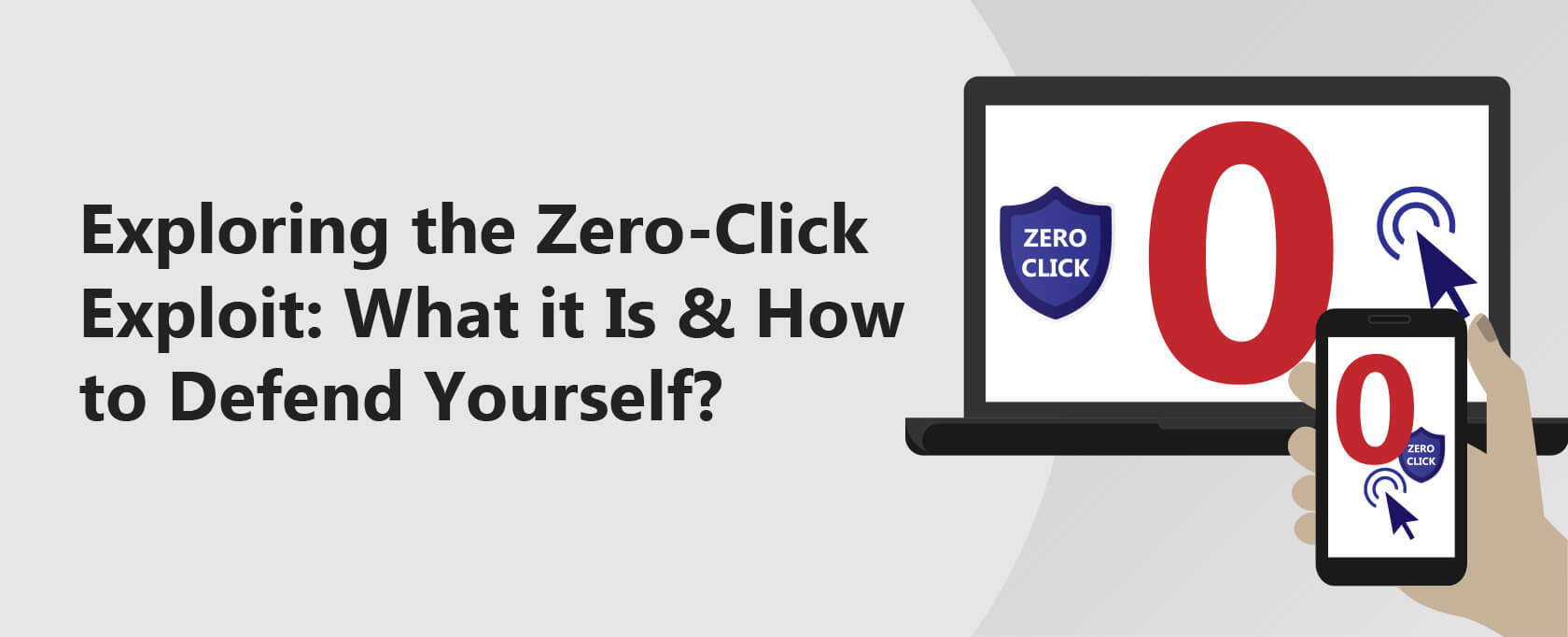Exploring the Zero-Click Exploit: What it Is & How to Defend Yourself?
Cybercriminals always remain on the go to come across sophisticated and new methods of exploiting users.
From malware to phishing attempts, achieving cybersecurity is a complex task in this modern world. This time a prominently rising form of cyber attack is the zero-click exploit.
The Pegasus spyware has circulated the recently discovered zero-click exploit, sneaking into iPhones and spying on users. An invention of the infamous Israeli NSO Group, the virus is stealthy, sneaky.
Moreover, it’s zero-click, meaning it doesn’t require users to click on anything and makes a cozy home within your iPhone without giving you the slightest hint.
The only way to remain secure is to install security patches that Apple keeps rolling out.
But this spyware incident is not the only zero-click exploit we have encountered this year. Alarmingly enough, the zero-click exploits have, unfortunately, grown significantly within 2021 alone and can cause damage of $ 1 million!
But since these attacks have recently grown in popularity, there remains little that we know about them! So what are these zero-day exploits, and how do they work?
Understanding Zero-Click Exploits: The Silent Cyber Threat
This guide delves into the rising threat of zero-click exploits, a type of cyberattack that requires no user interaction to execute.
What Are Zero-Click Exploits?
These sophisticated attacks exploit vulnerabilities in various devices, including those running iOS, Android, Windows, and macOS. Their goal is often to steal sensitive information or conduct surveillance on unsuspecting targets.
Notable Examples
- Pegasus Malware: Targeted iPhones using zero-click exploits to install spyware.
- WhatsApp Vulnerability: Enabled spyware installation through voice calls without user interaction.
Challenges and Protection
Zero-click exploits are particularly dangerous due to their stealthy nature, making them difficult to detect and prevent. However, you can bolster your defenses by:
- Practicing Strong Cyber Hygiene: Regularly review and update your security practices.
- Updating Device Operating Systems: Ensure all devices are running the latest software updates to patch known vulnerabilities.
- Being Cautious with App Installations: Only install apps from trusted sources and review permission settings carefully.
By adopting these proactive measures, you can enhance your protection against the sophisticated threat of zero-click exploits.
What are the Zero-Click Exploits?
The zero-click exploits are precisely what their names suggest. These hack attacks exploit a victim and can be executed with no voluntary action performed by the victim.
In contrast to a typical cyber-attack, you can fall victim to a zero-click attack by not even coming across a phishing simulation. The cybercriminal won’t have to dupe you into clicking a malicious link or downloading a malicious file into your device.
The only thing these zero-click exploits require is a vulnerability within your device, be it iOS, Android, Windows, or even macOS.
A threat actor can easily launch a zero-click attack by exploiting the data verification loophole within your system. These hacks are some of ht most sophisticated forms of cyberattacks that are on the rise nowadays.
They remain an invaluable resource to various threat actors. They are also frequently used to carry out sensitive data breach attacks, victimizing essential personnel such as journalists, politicians, or activists to spy on them, track them or collect their information.
How do the Zero-Click Exploits Work?
Since zero-click attacks happen sneakily and don’t require any effort on your part, it is somewhat perplexing how these attacks work.
Specifically, since all this time, we have grown to believe that our online actions can either make us a victim or save us from cyber-attacks. However, zero-click exploits are somewhat debunking that belief.
These zero-click exploits seem simple to execute since the threat actor doesn’t have to go through planting phishing simulations or clickbait.
However, these attacks are not easy to accomplish. A crucial aspect of launching a successful zero-click hack attack is sending a specially constructed data piece to the target’s device over wireless connections such as WiFi, NFC, Bluetooth GSM, or LTE.
The data chunk is designed to trigger an unknown or scarcely known vulnerability already present within the device, either at the software or hardware level.
The data chunk might exploit the vulnerability while getting processed by the device’s SoC (System on Chip Component). However, in most cases, the threat actor designs this vulnerability to be interpreted by specific target applications such as clients, including WhatsApp, Telegram or Skype, messenger, call service, or even SMS.
Therefore, the threat actor is also careful enough to construct a data pice that can be interpreted by such apps and might be in the form of:
-
MMS
- Voicemail
- Video conferencing sessions
- Text messages
- Authentication request
- Series of network packets
- Phone calls.
Once the data piece triggers the specific vulnerability within the device, the post-execution phase of the attack kicks in, featuring the payload executing predefined commands.
Pegasus Spyware and Other Popular Zero-Click Exploits
Although the zero-click exploits have recently become popular, they have been present for a considerable time and have built up a significantly large attack surface.
In recent years alone, several zero-click hack attacks have left mind-boggling effects highlighting the seriousness of such attacks. Some of the most prominent zero-click hacks in recent times are as follows:
Pegasus Spyware
In September, researchers at CitizenLab discovered a zero-click exploit in Apple’s iPhone device that allowed attackers to spy on their victims.
Developed by Israeli company NSO, the exploit allowed the threat actor to install the Pegasus malware in the target’s iPhone through a PDF file designed to execute the malicious code automatically.
Once the malware was successfully embedded into the device, it turned the iPhone not a hearing device for the threat actor.
WhatsApp Flaw
In 2019, WhatsApp Messenger became the gateway for cybercriminals to install spyware into several victim’s devices. The vulnerability was recognized as the “buffer flow vulnerability in Voice over Internet Protocol (VoIP).
Threat actors could activate it by calling the target’s Android or iOS device through a WhatsApp call embedded with rogue data packets.
Apple Mail App Flaws
In April, the cybersecurity company ZecOps discovered zero-click attacks within Apple’s Mail App.
The company published a write-up that informed how the vulnerability could be activated as cyber attackers sent specifically crafted emails to Mail users.
How Can You Defend Against Such Attacks?
Since these attacks are sneaky and hard to detect, there is little that we can do to defend against them. Admittedly we remain under the impression that these zero-click attacks only target important personnel, such as politicians or government officials.
The misconception probably arises from the fact that these attacks seem costly. However, it is crucial to debunk this concept as many zero-click attacks can also target the masses, such as the Apple above exploit.
But even if we accept the reality and consider ourselves possible targets, defense against a zero-click attack can be challenging.
The sneaky nature of these attacks makes them almost impossible to detect. However, practicing good cyber hygiene can somewhat help ensure security.
One most effective method of defense against such attacks is keeping your device’s OS updated. Since these attacks exploit vulnerabilities within your system, OS updates come with security patches against these vulnerabilities.
Besides that, while installing any new application, look into it carefully and be vigilant while giving permissions.
Another thing to remain to vary is to steer clear of jailbreaking your device. Jailbreak reduces your controls’ efficiency and safety restrictions built into your device.
Along with all that, there is always the generic but crucial cybersecurity practice you must follow, such as installing secure antimalware protection and encrypting your sensitive information.
Conclusion
Cyber-attacks have admittedly been on the rise for a considerable time now. Whether phishing attacks or zero-click attacks, it is about time we accept that we are never entirely secure online.
Therefore, it is crucial to remain vigilant and practice caution to protect yourself from falling victim.



1 Comment
A1 Lottery
April 10, 2025 11:37 am
This is such an eye-opening read! I had no idea zero-click exploits were so prevalent and dangerous. The tips on how to protect ourselves are really helpful. I’ll definitely be more cautious about my device security moving forward. Thanks for shedding light on this important topic!